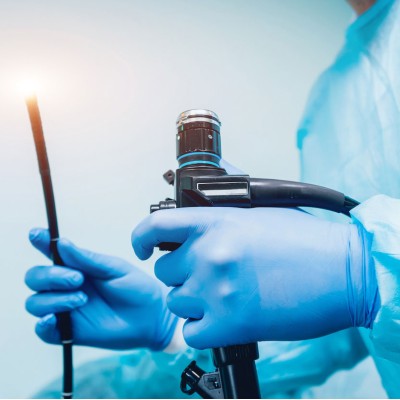LAPAROSCOPY
Laparoscopy is a type of surgical procedure that allows to access the inside of the abdomen (tummy) and pelvis without making large incisions in the skin. This procedure is also known as keyhole surgery or minimally invasive surgery.
In this state-of-the-art minimally invasive method, an instrument called a laparoscope (telescope) is utilized. It’s a small tube that has a light source and a camera, which relays images of the inside of the abdomen or pelvis to a television monitor. Nextly, via other small keyholes, operative instruments are introduced into the abdomen. The entire surgery is then carried out by looking at a TV monitor.
The advantages of this latest technique over traditional open surgery include:
-
- Less pain
- Less bleeding
- Short hospital stay
- Short recovery time
- Early return to work
- Reduced scarring
- Fewer chances of infection
The additional advantage of laparoscopy as compared to open surgery is that the disease inside the body is seen more clearly and hence can be removed completely as everything is magnified 20 times by the laparoscope & also the powerful light source highlights the area to be operated on.
Some common gynecological procedures done using laparoscopy:
1. Diagnostic Laparoscopy: It is used to investigate pelvic pain, infertility, or abnormal ultrasound or MRI findings by allowing direct visualization of the pelvic organs through laparoscope.
2. Laparoscopic Ovarian Cystectomy: Removal of ovarian cysts while preserving ovarian tissue eg simple ovarian cyst, dermoid cyst, endometriomas etc.
3. Laparoscopic Ovarian Drilling: It is performed in cases of polycystic ovary syndrome (PCOS) to induce ovulation by reducing androgen-producing stroma tissue. It also helps in reducing symptoms related to androgen excess like acne , hirsutism
4. Laparoscopic Myomectomy: Removal of uterine fibroids ( intramural, subserosal or submucosal) while retaining the uterus, particularly done in women facing infertility or wishing to preserve fertility.
5. Laparoscopic Endometriosis Surgery: Ablation or excision of endometriomas, endometrial implants to relieve pain and improve fertility issues related to endometriosis.
6. Laparoscopic Salpingectomy/Salpingo-oophorectomy: Removal of the fallopian tube (salpingectomy) in cases of ectopic pregnancy or affected tubes like hydrosalpinx or pyosalpinx . Removal of the tube along with the ovary (salpingo-oophorectomy), often used in ovarian tumors, or severe pelvic infections.
9. Laparoscopic Hysterectomy: Removal of the uterus through minimally invasive techniques.
10. Laparoscopic Tubal Ligation: A permanent method of sterilization where the fallopian tubes are clipped or cut using laparoscopic instruments leading to sterilisation.
Benefits of laparoscopy:
Laparoscopy offers the benefits of minimally invasive surgery, such as smaller incisions, reduced pain, quicker recovery time, and shorter hospital stays compared to open surgery.
If you need additional details on any of these procedures, feel free to ask Dr Shikha Sardana, Gynecologist , Vivant clinic sector 32 Chandigarh.
Hysteroscopy
Hysteroscopy is the inspection of the uterine cavity by passing the endoscope through the cervix. It is utilized to diagnose problems inside the uterine cavity. It also serves as a method for correction of most problems like polyp, submucosal fibroid, septum, adhesions, etc.
Here is a list of common hysteroscopic procedures:
1. Diagnostic Hysteroscopy: This involves inserting a hysteroscope (a small, lighted telescope) into the uterus to inspect the endocervical canal, uterine cavity and Ostia. It helps diagnose causes of abnormal bleeding, infertility, or recurrent miscarriages.
2.Polypectomy: Removal of endometrial polyps, which are generally benign growths that can lead to irregular bleeding or infertility.
3. Myomectomy: Hysteroscopic removal of submucosal fibroids (myomas) that project into the uterine cavity.
4. Septum Resection: At times uterine cavity might be divided in two halves by a septum in the cavity. Correction of a uterine septum by cutting and removing it to create a single, unified uterine cavity, may improve fertility and reduce miscarriage risk.
5. Adhesiolysis: The procedure involves the removal of intrauterine adhesions (scar tissue) formed as a result of trauma like DnC or infections like tuberculosis. This condition is labelled as Asherman’s syndrome. The Hysteroscopic adhesiolysis restores the normal uterine cavity and improve menstrual flow or fertility.
7. Removal of Retained Products of Conception (RPOC): Hysteroscopy is also used to remove remaining placental or fetal tissue following a miscarriage or abortion. This may help reduce bleeding and infection risks.

